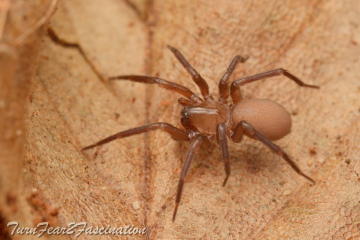Notes on Cicurina cicur

Cicurina cicur (Fabricius) in Yorkshire by Clifford J. Smith
From The Newsletter No. 54 March 1989
Although C. cicur was first recorded in Yorkshire as long ago as 1908, it is only since 1975 that the number of records has dramatically increased. When these data are analysed, two factors emerge clearly. Firstly, all recent records refer to those parts of the county where chalk or magnesian limestone is the basic geological formation. It is only in the southern parts of the latter that C. cicur has been recorded in the Maltby area, near Rotherham, but the spider has been found throughout the Yorkshire Wolds. The second factor is related to the method of capture and the time of year. Both chalk and magnesian limestone are quarried, the latter being used extensively in the building of such structures as York Minster and York City walls. Specimens have been found under stones in disused quarries, railway cuttings, etc., during the summer time and all such records apply to females. The use of pitfall trapping during the winter has added considerably to our records. Dr R M. Emberson, on a short visit to this country from New Zealand, was studying carabid beetles and, to this end, he undertook pitfall trapping on the chalk grassland of the Yorkshire Wolds during November and December 1982. Although almost completely unsuccessful with beetles, he nevertheless took numerous specimens of male C. cicur from many of the sites he selected on the northern edges of the Wolds chalk. More recently, Mr F. M. Wilson working from Rotherham Museum under the direction of the Curator, Mr W. A. Ely, has been trapping in a number of sites in the Maltby area of magnesian limestone during the period between November 1987 and February 1988. He too has taken a number of males, but females began to be taken towards the end of the period.
It is clear that, in Yorkshire, adult males are active during the early part of the winter, and that females can be
encountered throughout the year. Furthermore, it seems
as if the species is to be found on more open sites than
Locket and Millidge suggest in British Spiders II (1953).
The sites chosen by Emberson for his pitfall traps were
almost exclusively on steep, well-drained chalk hillsides in
typical dry Wolds valleys, with comparatively short grass
and occasional chalk stones. It is interesting that no records
have yet been made of this species in the extensive
limestone areas of the Pennines and Yorkshire Dales,
although they too have been subject to pitfall trapping in
the winter.
Added by John Partridge at 14:09 on Wed 11th Jan 2012.
Cicurina cicur (Fabricius) in Yorkshire
by Clifford J. Smith
From The Newsletter No. 54 March 1989
Although C. cicur was first recorded in Yorkshire as long ago as 1908, it is only since 1975 that the number of records has dramatically increased. When these data are analysed, two factors emerge clearly. Firstly, all recent records refer to those parts of the county where chalk or magnesian limestone is the bask geological formation. It is only in the southern parts of the latter that C. cicur has been recorded in the Maltby area, near Rotherham, but the spider has been found throughout the Yorkshire Wolds. The second factor is related to the method of capture and the time of year. Both chalk and magnesian limestone are quarried, the latter being used extensively in the building of such structures as York Minster and York City walls. Specimens have been found under stones in disused quarries, railway cuttings, etc., during the summer time and all such records apply to females. The use of pitfall trapping during the winter has added considerably to our records. Dr R M. Emberson, on a short visit to this country from New Zealand, was studying carabid beetles and, to this end, he undertook pitfall trapping on the chalk grassland of the Yorkshire Wolds during November and December 1982. Although almost completely unsuccessful with beetles, he nevertheless took numerous specimens of male C. cicur from many of the sites he selected on the northern edges of the Wolds chalk More recently, Mr F. M. Wilson working from Rotherham Museum under the direction of the Curator, Mr W. A. Ely, has been trapping in a number of sites in the Maltby area of magnesian limestone during the period between November 1987 and February 1988. He too has taken a number of males, but females began to be taken towards the end of the period.
It is clear that, in Yorkshire, adult males are active during the early part of the winter, and that females can be
encountered throughout the year. Furthermore, it seems
as if the species is to be found on more open sites than
Locket and Millidge suggest in British Spiders II (1953).
The sites chosen by Emberson for his pitfall traps were
almost exclusively on steep, well-drained chalk hillsides in
typical dry Wolds valleys, with comparatively short grass
and occasional chalk stones. It is interesting that no records
have yet been made of this species in the extensive
limestone areas of the Pennines and Yorkshire Dales,
although they too have been subject to pitfall trapping in
the winter.
Added by John Partridge at 14:07 on Wed 11th Jan 2012.
Return to Summary for Cicurina cicur